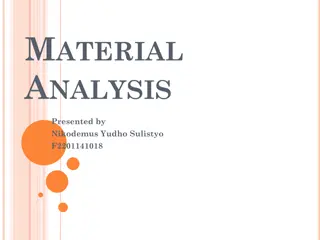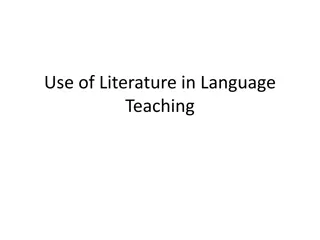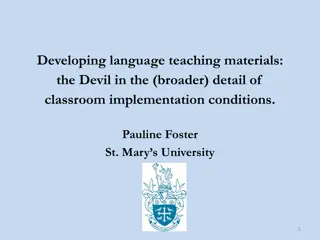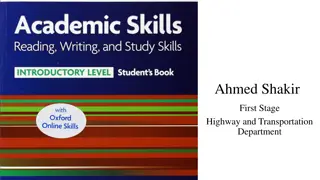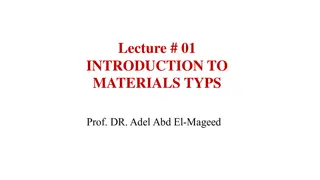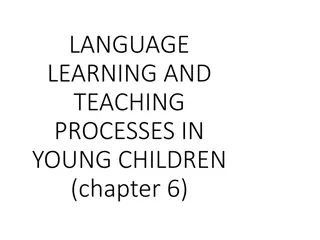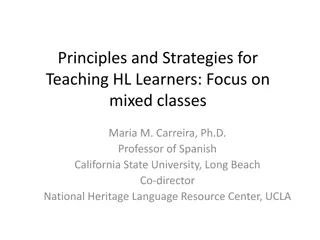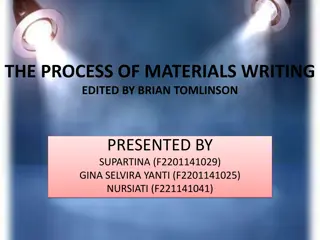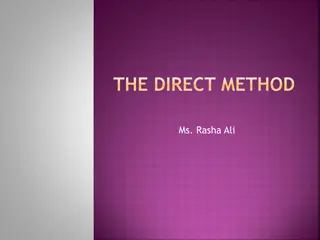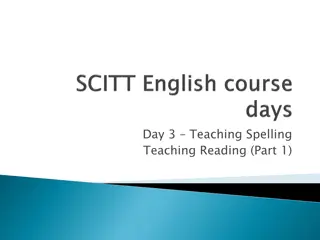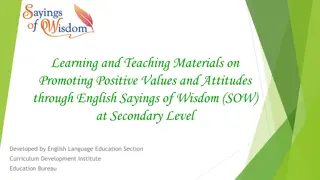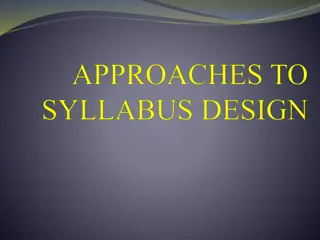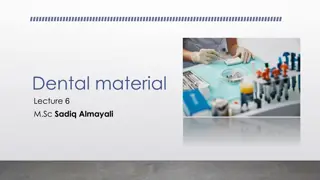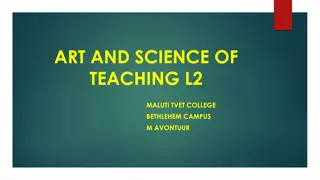Exploring Language Teaching Materials Development
Language teaching materials play a crucial role in language learning processes. They can be informative, instructional, experiential, eliciting, or exploratory. Materials development involves various processes such as evaluation, adaptation, design, production, exploitation, and research. Frameworks and key components help in structuring and organizing lesson formats for effective language teaching. Different practitioners offer unique approaches to materials development, contributing to the enhancement of language learning experiences.
Download Presentation

Please find below an Image/Link to download the presentation.
The content on the website is provided AS IS for your information and personal use only. It may not be sold, licensed, or shared on other websites without obtaining consent from the author. Download presentation by click this link. If you encounter any issues during the download, it is possible that the publisher has removed the file from their server.
E N D
Presentation Transcript
Understanding Language Teaching Materials Development PRESENTED BY: YUSNITA, PURWATI AND RATNA
Teaching Learning Materials Materials can be: Informative (informing the learner about the target language) Instructional (guiding the learner in practising the language) Experiential (providing the learner with experience of the language in use) Eliciting (encouraging the learner to use the language) Exploratory (helping the learner to make discoveries about the language).
Examples of materials: Videos DVDs Emails YouTube Dictionaries Grammar books Readers Newspaper Teacher s instruction
What does Materials development mean? Materials development refers to all the processes made use of by practitioners who produce and/or use materials for language learning, including materials evaluation, their adaptation, design, production, exploitation and research. Ideally, all of these processes should be given consideration and should interact in the making of language-learning materials. Materials development is both a field of study and a practical undertaking. As a field it studies the principles and procedures of the design, implementation and evaluation of language teaching materials
Frameworks for materials development Richards (1995:102-103) describes frameworks as the process of designing a design or frame for a unit in a textbook which can serve as a formulae which the author can use in writing the book Flores (1995:60-62) also describes frameworks that outline a lesson format with the following basic stage:
Key components in lesson format Starter Input General information Language focus Tasks
Basic stages in outlining a lesson format Listening with Understanding Using Grammar in Oral Interaction Reading for Understanding Literature Writing
Jolly and Bolitho (1998:97-98) have an interestingly different approach to frameworks and focus not on a unit frameworks but on a framework for developing materials, which involves the following procedures: Identification of need for materials Exploration of need Contextual realization of materials Pedagogical realization of materials Productions of materials Student use of materials Evaluation of objectives materials against agreed
The basic principles of SLA relevant to the development of materials for the teaching of languages 2. Materials should help learners to feel at ease 1. Materials should achieve impact Most learners feel more comfortable with written materials with lots of white space Learners are more at ease with texts and illustration that they can relate to their own culture Learners are more relaxed with materials which are obviously trying to help them to learn Novelty Variety Attractive presentation Appealing content Achievable challange
The basic principles of SLA relevant to the development of materials for the teaching of languages 4. What is being taught should be perceived by learners as relevant and useful 3. Materials should help learners to develop confidence By points to interesting and challenging tasks and by presenting them in ways which could achievement of the task outcomes desired by the learners. relating teaching Relaxed and self- confident learners learn faster (Dulay, Burt and Krashen in Tomlinson, 2011: 10) classroom facilitate
The basic principles of SLA relevant to the development of materials for the teaching of languages 6. Learners must be ready to acquire the points being taught 5. Materials should require and facilitate learner self-investment By materials which create situations requiring the use of variational previously taught By materials which ensure that the learners have gained sufficient mastery over the developmental features of the previous stage before teaching a new one By materials learners to focus attention on features of the target language By providing learners with choices of focus and activities Involving the learners in mini-projects Involving learners in finding supplementary materials for particular units in a book features not which get
The basic principles of SLA relevant to the development of materials for the teaching of languages 8. The learners attention should be drawn to linguistic features of the input 7. Materials should expose the learners to language in authentic use It understand that learners need to pay attention to linguistic authentic input The important thing is that the learners become aware of a gap between the interlanguage equivalent feature in the target language is important to The advice they give The instructions for their activities The spoken and written texts they include The activities suggest features of and the they
The basic principles of SLA relevant to the development of materials for the teaching of languages 9. learners with opportunities to use target language communicative purposes Materials should provide the 10. account that the positive effects of instruction are usually delayed Materials should take into to achieve Information activities which require learners to communicate Post-listening and post-reading activities which learners to use information from the text Creative writing and creative speaking activities (writing a story) Formal instruction given in the target language either on the langugae itself or opinion gap To gradual acquisition, important for materials to recycle instruction and to provide frequent facilitate process the of is it require the
The basic principles of SLA relevant to the development of materials for the teaching of languages 12. Materials should take into account that learners different in affective attitude 11. Materials should take into account that learners differ in learning styles Styles which need to be catered:visual, auditory, kinaesthetic, studial, experiential, analytic, global, dependent, independent. The important point for materials developers is that they are aware of and cater for different of preferred learning styles in their materials. One implication is to diversify language instructions. Ways of doing this: Providing choices of different text and types of activities Providing optional extras for the more positive and motivated learners; and variety Including units in which the value of learning English is a topic for discussion, involve the learners in discussion Being aware of the cultural sensitivies Specific advice to respond to negative learners
The basic principles of SLA relevant to the development of materials for the teaching of languages 13. Materials should permit a silent period at the beginning of instruction 14. Materials should maximize learning potential It is extremely valuable to delay L2 speaking for beginners until they have gained sufficient exposure Possible ways include: - Starting the course with TPR - Starting with listening comprehension approach - Permitting to respond by using first language or through drawings or gestures It is done by encouraging intellectual, aesthetic, and emotional involvement which stimulates both right and left brain activities It is important that the content is not trivial or banal to lead to deeper and more durable learning. The maximisation of the brain s learning potential is fundamental as in suggestopedia: enabling learners to receive information through cerebral process
The basic principles of SLA relevant to the development of materials for the teaching of languages 16. Materials should provide opportunities for outcome feedback 15. Materials should not rely too much on controlled practice Ellis (1990; 192): controlled practice has little long term effect on accuracy on accuracy and fluency Dominance is still shown in some low level course books, resulting in many students and teachers wasting their time for drills, listening to and repeating dialogues If the language that the learner produces is evaluated in relation to the purpose for which it is used, that language can become a powerful and informative source of information about the language use. It is very important for materials developers yo make sure that language production activities have intended outcome other than just practising language
Principles in Materials Development Most writers on the process of the materials development focus on needs analysis as starting point. And some writers report starting by articulating their principles. Bell and Gower (1998:122-125) articulating principles which they wanted to guide their writing: started by
Flexibility From text to language Engaging content Natural language Analytic approaches Emphasis on review Personalized practice Integrated skills Balance of approaches Learner development Professional respect
Tomlinson (1999b) describes a principled and flexible framework designed to help teachers to develop materials efficiently and effectively. Penaflorida (1995:172-179) reports her use of the six principles of materials design identified by Nunan (1988): a. Materials should be clearly linked to the curriculum they serve. b. Materials should be authentic in terms of text and task
c. Materials should stimulate interaction d. Materials should allow learners to focus on formal aspects of the language e. Materials should encourage learners to develop learning skills, and skills in learning f. Materials should encourage learners to apply their developing skills to the world beyond the classroom.
A Text-driven Approach to Materials Development Tomlinson s own preference is the text-driven approach, in which an engaging written or spoken text drives a unit of materials in which readiness activities activate the learners minds in relation to the text, initial response activities stimulate engagement whilst experiencing the text, intake response activities encourage articulation of personal responses, input response exploration of features of the text and development activities encourage learner production (Tomlinson 2003c). activities invite
Table of a summary of the text-driven framework Stage Text Collection Procedure Find or create potentially engaging texts (written or spoken) Select a text suitable in level and theme for your target learners Principles Affective engagement is a prerequisite for durable learning Objectives To build a library of text with the potential for engaging learners Text Selection Texts need to be matched with learners To find a text with the potential for useful engagement for the target learners To start from an experience which you can try to help the learners to approximate. Text Experience Read or listen to the text experientially Apprehension should come before comprehension
Readiness Activities Devise activities which could help the learners achieve mental readiness for experiencing the text Devise whilst- reading or listening activities which will help the learners to process the text in an experiential way Inner speech and the establishment of affective and cognitive connections Multidimensional way they would automatically use when experiencing an L1 text. Experiential Activities L2 learners tend to process a text in a studies way in an insecure attempt to achieve total comprehension To help the learners to move away from their tendency to study texts so that they can engage with the text instead experientially
Intake Response Activities Devise activities which help learners to articulate and develop their mental representation of the text Learning is facilitated by starting positively from what the learners do know and understand To encourage learners to process their representation of a text rather than the text itself and to encourage them to be relaxed and confident in their response to texts. Development Activities Devise activities which help the learners to use their representation of the text as a basis for language production activities Mental connections facilitate learning To help learners express themselves in the target language intelligently and creatively
Input Response Activities Devise activities which help the learners to go back to the text and to discover patterns and regularities of language use in the text A good time to analyze a text is just after an enjoyable multidimensional experience of it, Helping learners to make discoveries for themselves can be an effective way of promoting long- term learning To get the learners to develop their analytical skills and their ability to make discoveries about the use of the target language for themselves. Trialling Try out the materials with a typical target class Matching materials to learners needs and wants is an ongoing, dynamic process To find out how usable and motivating the materials are
Evaluation Use questionnaires, interviews and analysis of the learners work to find out what effect the materials had on the learners Giving learners a chance to evaluate their learning process can not only provide useful information but can also motivate and stimulate learners Materials developers and teachers need constantly to improve their materials to achieve a closer match with learners need and wants To show learners they are respected and to find out what effect the materials had on them Revision Produce an improved version of the materials To match the needs and wants of the learners
Although the framework above is primarily text-driven it can be adapted to become an activity-driven framework with the text to base the activities on being chosen by the learners from a library of texts either provided for them or built up over a period of time by themselves. Materials can be based on units of the text genres (e.g, advertisement, reports, jokes, announcements, stories, etc) and the learners can be asked to find an appropriate and engaging text from the internet.
Conclusion Tomlinson s argument is that the activities in a course should match with learner needs and wants and with principles of language learning, and that they should be developed in ways which provide flexibility of use as well as coherence of connection. Consideration: target context of use for the materials and principles; experience of the writers; developing a flexible framework. The writing process will start with the learner as the focus and with principles in mind.
REFERENCES Tomlinson, Brian. (2011). Materials Development in Language Teaching. Cambridge: Cambridge University Press. Tomlinson, Brian (Ed.). (2003). Developing Materials for Language Teaching. New York: Cromwell Press.


